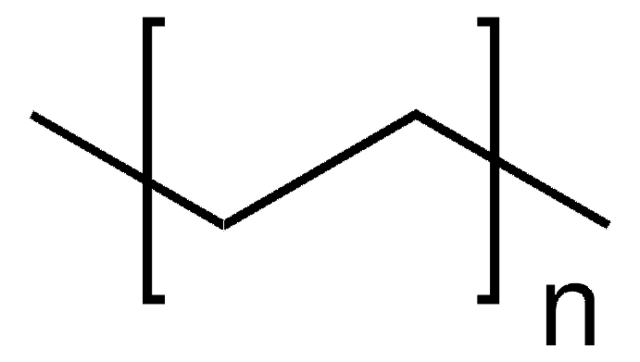03394
Poli(etilenoglicol)
tested according to Ph. Eur., 6,000
Sinônimo(s):
PEG
Faça loginpara ver os preços organizacionais e de contrato
About This Item
Fórmula linear:
H(OCH2CH2)nOH
Número CAS:
Número MDL:
Código UNSPSC:
12352104
ID de substância PubChem:
NACRES:
NA.21
Produtos recomendados
Agency
tested according to Ph. Eur.
Nível de qualidade
Formulário
solid
peso molecular
5000-7000
solubilidade
aliphatic hydrocarbons: slightly soluble
organic solvents: soluble
aplicação(ões)
pharmaceutical (small molecule)
cadeia de caracteres SMILES
C(CO)O
InChI
1S/C2H6O2/c3-1-2-4/h3-4H,1-2H2
chave InChI
LYCAIKOWRPUZTN-UHFFFAOYSA-N
Procurando produtos similares? Visita Guia de comparação de produtos
Aplicação
Poly(ethylene glycol) was used as hydrophilic carriers for characterizing the sirolimus solid dispersion nanoparticles.
Ações bioquímicas/fisiológicas
Polyethylene glycol (PEG) is a condensation polymer of ethylene oxide and water. It enhances the refolding of extracted proteins. This enables characterization of crystallized proteins.
Nota de preparo
Poly(ethylene glycol) dissolves in many organic solvents and is readily soluble in aromatic hydrocarbons. It also slightly dissolves in aliphatic hydrocarbons.
Código de classe de armazenamento
11 - Combustible Solids
Classe de risco de água (WGK)
WGK 1
Ponto de fulgor (°F)
Not applicable
Ponto de fulgor (°C)
Not applicable
Equipamento de proteção individual
Eyeshields, Gloves, type N95 (US)
Escolha uma das versões mais recentes:
Já possui este produto?
Encontre a documentação dos produtos que você adquiriu recentemente na biblioteca de documentos.
Os clientes também visualizaram
J L Cleland et al.
Bio/technology (Nature Publishing Company), 10(9), 1013-1019 (1992-09-01)
Previous studies on the refolding of recombinant bovine carbonic anhydrase B (CAB) indicated that polyethylene glycol (PEG) significantly enhanced the recovery of active protein by reducing aggregation. To further test the ability of PEG to enhance refolding, three recombinant human
J L Cleland et al.
The Journal of biological chemistry, 267(19), 13327-13334 (1992-07-05)
Polyethylene glycol (PEG) inhibited aggregation during refolding of bovine carbonic anhydrase B (CAB) through the formation of a nonassociating PEG-intermediate complex. Stoichiometric concentrations of PEG were required for complete recovery of active protein during refolding at aggregating conditions. For example
Min-Soo Kim et al.
International journal of nanomedicine, 6, 2997-3009 (2011-12-14)
The aim of this study was to improve the physicochemical properties and bioavailability of poorly water-soluble sirolimus via preparation of a solid dispersion of nanoparticles using a supercritical antisolvent (SAS) process. First, excipients for enhancing the stability and solubility of
Idalis Villanueva et al.
Acta biomaterialia, 5(8), 2832-2846 (2009-06-11)
The pericellular matrix (PCM) surrounding chondrocytes is thought to play an important role in transmitting biochemical and biomechanical signals to the cells, which regulates many cellular functions including tissue homeostasis. To better understand chondrocytes interactions with their PCM, three-dimensional poly(ethylene
Mark A Rice et al.
Acta biomaterialia, 5(1), 152-161 (2008-09-17)
Ultrasound has potential as a non-destructive analytical technique to provide real-time online assessments of matrix evolution in cell-hydrogel constructs used in tissue engineering. In these studies, chondrocytes were encapsulated in poly(ethylene glycol) hydrogels, and gel degradation was manipulated to provide
Nossa equipe de cientistas tem experiência em todas as áreas de pesquisa, incluindo Life Sciences, ciência de materiais, síntese química, cromatografia, química analítica e muitas outras.
Entre em contato com a assistência técnica




